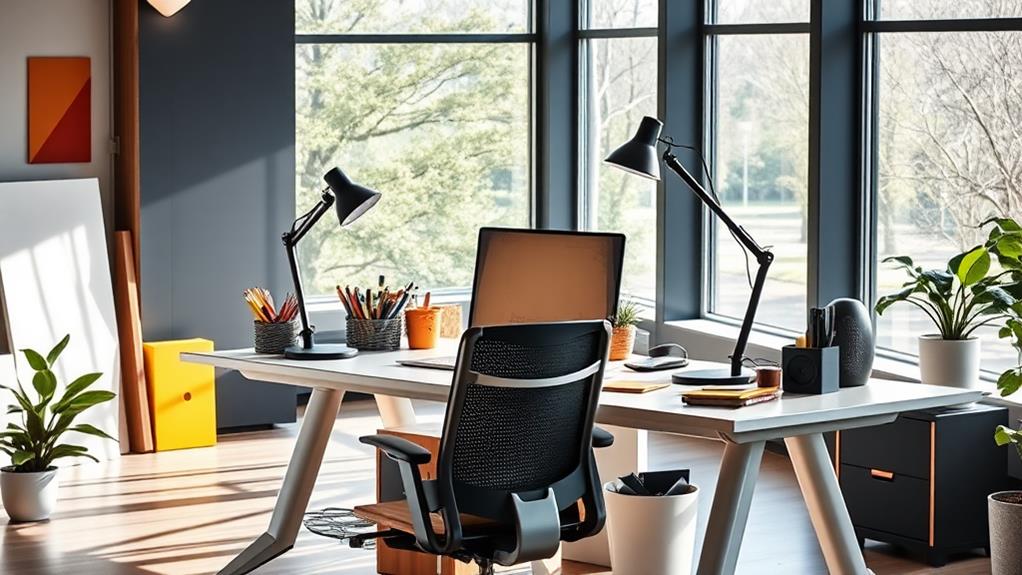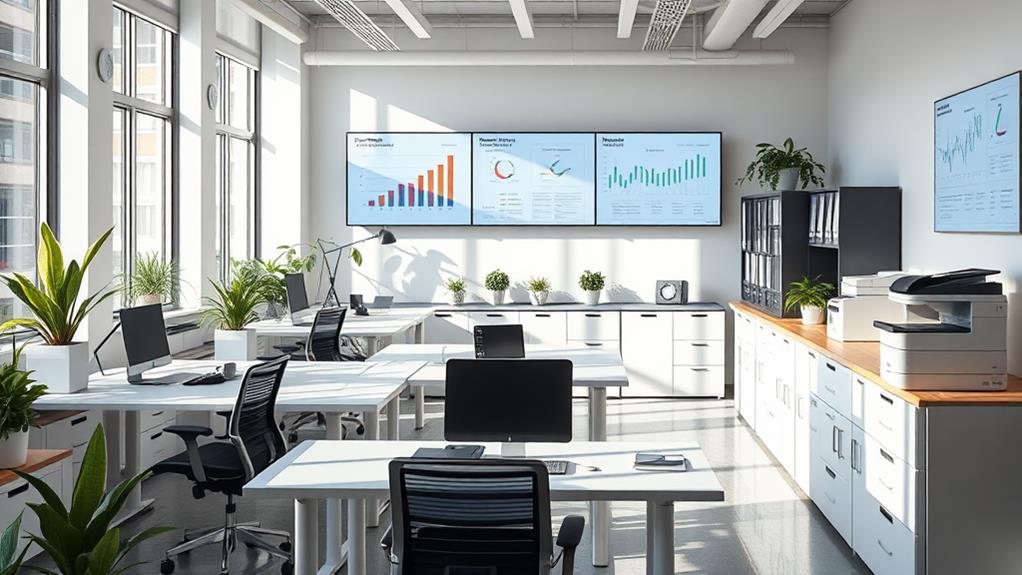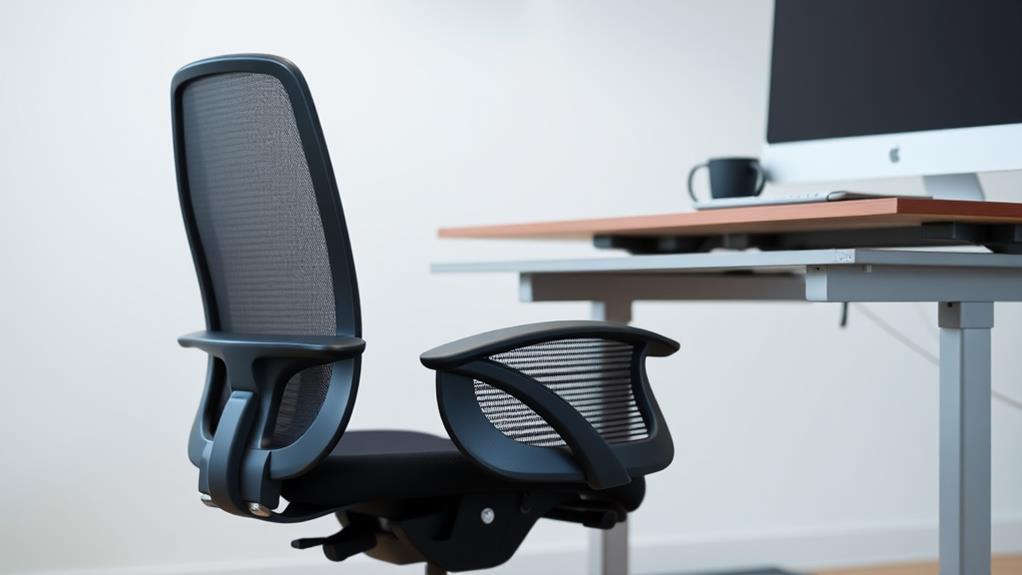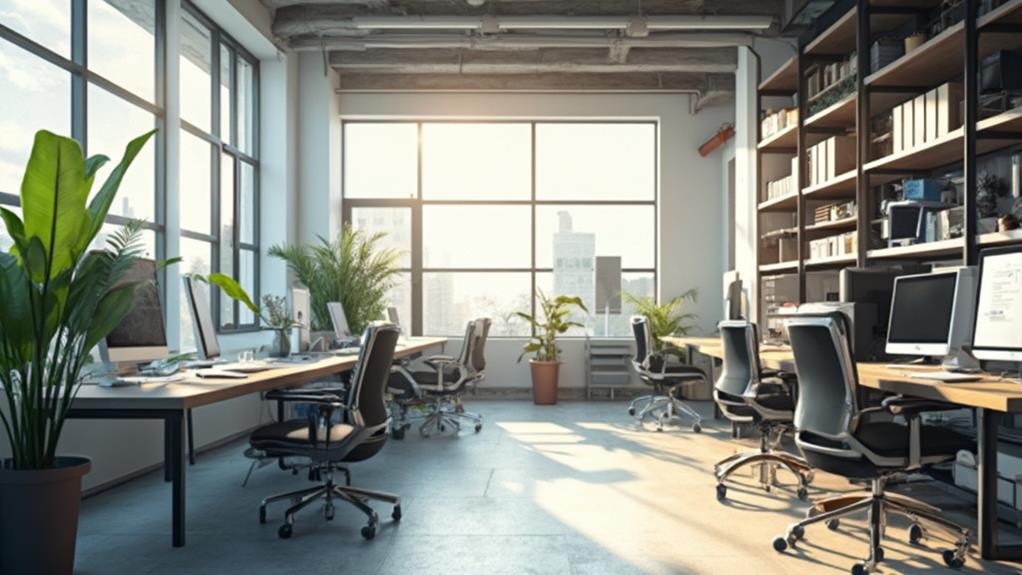Office equipment suppliers can enhance their online presence and customer engagement by creating compelling blog content that transforms mundane office supplies into engrossing narratives. By personifying office supply heroes, exploring quirky origin stories, and offering practical workplace organization advice, suppliers can create content that resonates with their audience. This approach not only fosters a sense of camaraderie and appreciation for essential tools but also provides an opportunity to investigate the innovative spirit behind common office supplies. Additionally, incorporating topics such as ergonomic furniture selection, proper equipment adjustment, and workplace organization adventures can offer valuable insights to readers. Further exploration of these strategies can yield significant benefits for suppliers seeking to improve their content marketing efforts.
Office Equipment Highlights
- Personify office supplies as workplace heroes to create relatable, engaging narratives that resonate with readers.
- Share quirky origin stories of common office items to spark curiosity and emphasize innovation.
- Develop content around workplace organization adventures, highlighting creative solutions and challenges.
- Showcase how modern office equipment improves productivity, efficiency, and long-term cost savings.
- Emphasize the importance of ergonomics in office equipment selection to promote employee well-being and satisfaction.
Engaging Office Supply Narratives

In the domain of office supply narratives, there exists a wealth of engaging content possibilities that can captivate readers and potential customers. By personifying office supplies as heroes, crafting quirky origin stories for everyday items, and recounting workplace organization adventures, suppliers can create relatable and memorable content.
These narrative approaches not only entertain but also educate readers about the practical applications and unique features of various office products, potentially influencing purchasing decisions and brand loyalty. Incorporating stories about copier lead generation can add a fresh perspective to office equipment content, showcasing how modern technology streamlines business processes.
These narratives can highlight the ease of getting started with new office solutions and the potential for increased sales through targeted leads.
Personify Office Supply Heroes
Every office has its unsung heroes, quietly standing by to save the day when chaos threatens productivity. These unassuming champions, often overlooked in the daily bustle, are the office supplies that form the backbone of efficient operations. By personifying these essential tools, suppliers can create engaging content that resonates with their audience, fostering a sense of camaraderie and appreciation for the role each item plays in the workplace ecosystem.
Consider the steadfast stapler, always ready to bind important documents with unwavering precision, or the versatile sticky note, adept at capturing fleeting ideas and reminders. The noble printer cartridge, tirelessly producing crisp, professional output, and the dependable surge protector, standing guard against electrical mishaps, are equally deserving of recognition. By crafting narratives that highlight the unique attributes and contributions of these office supply heroes, suppliers can elevate their products from mere commodities to indispensable allies in the pursuit of workplace excellence. This approach not only educates consumers about the importance of quality supplies but also cultivates a deeper connection between users and the tools they rely on daily.
Quirky Supply Origin Stories
Curiosity drives engagement, and office supply narratives can captivate readers by revealing the quirky origin stories behind everyday items. These tales not only entertain but also foster a sense of connection between users and their tools.
For instance, the humble Post-it note, a staple in offices worldwide, emerged from a failed experiment to create a super-strong adhesive. Similarly, the ubiquitous ballpoint pen resulted from László Bíró's frustration with the messiness of fountain pens, leading him to develop a revolutionary writing instrument inspired by the quick-drying ink used in newspaper printing.
Exploring these narratives provides an opportunity to investigate into the innovative spirit behind common office supplies. The paper clip, for example, evolved from a simple piece of bent wire into various designs, each with its own unique story of invention and refinement.
Workplace Organization Adventures
Offices transform into organizational battlegrounds as employees commence on workplace organization adventures. These quests for order and efficiency often lead to innovative solutions and unexpected challenges.
As office equipment suppliers, understanding and catering to these organizational endeavors can provide valuable insights into product development and customer needs.
To effectively support workplace organization adventures, consider the following key aspects:
- Flexibility: Offer adaptable storage solutions that can evolve with changing office layouts and needs
- Ergonomics: Prioritize products that promote comfort and proper posture to enhance productivity
- Sustainability: Incorporate eco-friendly materials and designs to appeal to environmentally conscious clients
- Technology integration: Develop products that seamlessly blend with modern digital workflows
Benefits

Investing in quality office equipment yields numerous advantages for businesses of all sizes. The benefits extend beyond mere functionality, encompassing increased productivity and efficiency, long-term cost savings, improved workplace ergonomics, and an enhanced professional image.
For office equipment suppliers, exclusive leads can help connect with potential customers actively seeking these advantages. These advantages collectively contribute to a more effective, comfortable, and impressive work environment, ultimately supporting the overall success and growth of the organization.
Increased Productivity and Efficiency
Through strategic investment in modern office equipment, businesses can greatly boost their productivity and efficiency. By upgrading outdated machinery and implementing cutting-edge technologies, companies can streamline their operations, reduce bottlenecks, and optimize workflow processes. This enhanced efficiency translates into tangible benefits, such as faster turnaround times, improved quality of work, and increased output.
To fully realize the potential of increased productivity and efficiency, organizations should consider the following key factors:
- Ergonomic design: Equipment that prioritizes user comfort and reduces physical strain
- Integration capabilities: Seamless connectivity between devices and software systems
- Automation features: Functions that minimize manual intervention and repetitive tasks
- Scalability: Ability to accommodate growth and evolving business needs
Cost Savings Over Time
While the immediate benefits of increased productivity and efficiency are evident, the long-term financial advantages of investing in modern office equipment are equally compelling. Over time, businesses can realize substantial cost savings through reduced maintenance expenses, lower energy consumption, and decreased paper usage.
Modern office equipment often incorporates energy-efficient technologies, leading to lower utility bills and a smaller carbon footprint. Additionally, the improved reliability of newer equipment translates to fewer breakdowns and repairs, minimizing costly downtime and maintenance fees.
Furthermore, the integration of digital solutions and cloud-based technologies can drastically reduce paper and ink consumption, leading to ongoing savings in supply costs. Advanced document management systems and multifunction devices streamline workflows, reducing the need for multiple standalone machines and their associated maintenance contracts.
The scalability of modern office equipment also allows businesses to adapt to changing needs without frequent replacements, providing a better return on investment. By carefully analyzing the total cost of ownership, including purchase price, operational costs, and potential savings, companies can make informed decisions that yield substantial financial benefits in the long run, ultimately contributing to a healthier bottom line.
Improved Workplace Ergonomics
Beyond productivity gains and cost savings, modern office equipment plays an essential role in enhancing workplace ergonomics. Ergonomically designed furniture and tools contribute substantially to employee comfort, health, and overall well-being. By investing in ergonomic office solutions, companies demonstrate their commitment to creating a supportive work environment that prioritizes the physical welfare of their staff.
Improved workplace ergonomics offers numerous benefits for both employees and employers:
- Reduction in work-related musculoskeletal disorders, leading to decreased absenteeism and workers' compensation claims
- Enhanced employee comfort and satisfaction, resulting in improved morale and retention rates
- Increased productivity due to reduced physical strain and fatigue during work hours
- Compliance with occupational health and safety regulations, mitigating potential legal risks
When selecting office equipment, it is imperative to consider ergonomic features such as adjustable chair heights, sit-stand desks, and ergonomic keyboards. These elements can be customized to accommodate individual needs, promoting proper posture and reducing the risk of repetitive strain injuries. By prioritizing ergonomics in the workplace, organizations create an environment that fosters long-term employee health and productivity, ultimately contributing to the company's success and growth.
Enhanced Professional Image
The appearance of an office speaks volumes about a company's professionalism and attention to detail. High-quality office equipment not only enhances functionality but also contributes immensely to a business's image. When clients, partners, or potential employees visit the workplace, they form immediate impressions based on the visual aesthetics and overall ambiance.
Modern, well-maintained office equipment conveys a sense of competence, success, and forward-thinking.
Investing in premium office furniture, state-of-the-art technology, and sleek organizational systems demonstrates a commitment to excellence and creates an environment that inspires confidence. Ergonomic chairs, adjustable desks, and cable management solutions contribute to a clean, organized appearance while simultaneously promoting employee well-being. Additionally, strategically placed equipment, such as multi-function printers or collaborative workstations, can showcase a company's efficiency and innovative approach to business operations.
Ergonomic Furniture Selection Tips

Selecting ergonomic office furniture is vital for maintaining employee health, productivity, and comfort in the workplace. When choosing ergonomic furniture, it is necessary to consider three key factors: proper chair adjustment, appropriate desk height, and correct monitor positioning. The following table outlines important considerations for each of these elements, helping office managers and employees make informed decisions about their workspace setup:
| Chair Adjustment | Desk Height | Monitor Positioning |
|---|---|---|
| Seat height | Elbow angle | Eye level |
| Lumbar support | Keyboard placement | Distance from eyes |
| Armrest position | Legroom | Tilt angle |
| Backrest tilt | Standing option | Glare reduction |
Proper Chair Adjustment
Sitting at the heart of workplace comfort, proper chair adjustment plays an essential role in maintaining employee well-being and productivity. As office equipment suppliers, it's critical to educate clients on the importance of correct chair setup, ensuring that each team member can maximize their seating for maximum ergonomic benefit.
A well-adjusted chair not only promotes better posture but also reduces the risk of musculoskeletal disorders, enhancing overall workplace satisfaction and efficiency.
To achieve peak chair adjustment, consider the following key steps:
- Adjust seat height so feet are flat on the floor and knees are at a 90-degree angle
- Set the backrest to support the natural curve of the spine, with particular attention to lumbar support
- Position armrests to allow relaxed shoulders and elbows at a 90-degree angle
- Ensure proper seat depth, leaving 2-4 inches between the edge of the seat and the back of the knees
Desk Height Matters
Beyond chair adjustments, desk height emerges as a critical factor in creating an ergonomic workspace. An appropriately positioned desk can notably impact posture, comfort, and overall productivity, making it an essential consideration for office managers and employees alike.
The ideal desk height allows users to maintain a neutral posture, with arms resting comfortably at a 90-degree angle when typing or writing. This positioning helps reduce strain on the shoulders, neck, and back, contributing to long-term musculoskeletal health.
When selecting desks for your office, consider adjustable options that accommodate various body types and working styles. Height-adjustable desks, in particular, offer flexibility for users to alternate between sitting and standing positions throughout the day, promoting better circulation and reducing the risks associated with prolonged sedentary behavior.
It is crucial to coordinate desk height with chair height and monitor placement to create a cohesive ergonomic setup. By investing in properly sized desks and educating employees on correct usage, organizations can foster a more comfortable and efficient work environment, potentially reducing absenteeism and improving overall job satisfaction among team members.
Monitor Positioning Essentials
Proper monitor positioning complements ergonomic desk and chair setups to create a fully optimized workspace. When selecting and arranging monitors, consider factors such as height, distance, and angle to reduce eye strain and neck discomfort. Proper positioning enhances productivity and contributes to overall well-being in the office environment.
To guarantee ideal monitor placement, follow these essential guidelines:
- Position the top of the screen at or slightly below eye level, allowing for a slight downward gaze
- Maintain a distance of approximately arm's length between the user and the monitor
- Tilt the screen slightly backward, typically between 10 to 20 degrees
- Align the monitor directly in front of the user to avoid unnecessary neck rotation
Office Equipment FAQ
How Often Should Office Equipment Be Replaced or Upgraded?
Office equipment replacement frequency depends on usage, technological advancements, and business needs. Generally, computers should be upgraded every 3-5 years, while printers and copiers may last 5-7 years. Regular maintenance can extend equipment lifespan and improve team productivity.
What Are the Most Cost-Effective Ways to Maintain Office Equipment?
To maintain office equipment cost-effectively, implement regular cleaning routines, schedule preventive maintenance, train staff on proper usage, and promptly address minor issues. These practices extend equipment lifespan, reduce downtime, and foster a sense of collective responsibility among team members.
Which Office Supplies Are Essential for a New Startup?
For a new startup, essential office supplies include:
- Quality laptops/computers
- Ergonomic chairs and desks
- Reliable printer/scanner
- Filing cabinets
- Whiteboards
- Stationery basics (pens, notebooks, sticky notes)
- Coffee maker (for team bonding!)
These essentials foster productivity and collaboration.
How Can We Reduce Paper Waste in Our Office?
To reduce paper waste in our office, we can implement digital document management systems, encourage double-sided printing, set print quotas, and promote a paperless culture. These practices not only save resources but also foster a sense of environmental responsibility among our team.
What Are the Latest Trends in Smart Office Technology?
Smart offices are embracing AI-powered assistants, IoT-connected devices, and cloud-based collaboration tools. We're seeing a rise in touchless technology, smart lighting and climate control, and flexible workspaces that adapt to our team's evolving needs.


Recent Comments